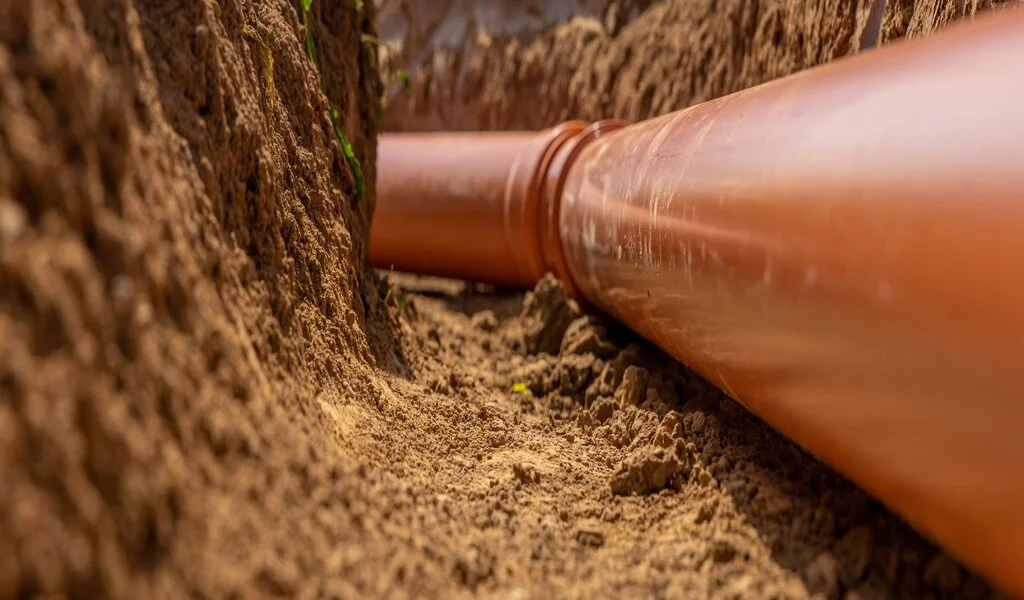Underground drainage refers to the network of pipes and fittings installed beneath the ground to transport foul drainage or rainwater to a sewage treatment plant, soakaway, or watercourse.
Most underground drainage systems in the UK are manufactured in PVCu, which is both hardwearing and easy to maintain.
Underground drainage pipes are terracotta orange (brown) in colour – making them easy to identify – and they have a smooth inner wall that promotes better flow.
But how do you connect pipes to your underground drainage system?
In this blog, we’ll explore the six steps required to join underground drainage pipes properly.
Step 1 – Plan the drainage system
An architect or drainage engineer will usually map out the location of pipes, the direction they are to run, and where they will connect to the main sewer system.
Depending on the flow rate, you’ll need to choose a suitable pipe size.
110mm underground drainage pipes are the go-to choice for domestic systems, whilst 160mm diameters are required when multiple properties are joined to the same drainage system.
Considering any potential obstacles, including (but not limited to) trees, pavements, and buildings will avoid the need for sharp or unnecessary turns.
Step 2 – Acquire the tools you need
When it comes to connecting underground drainage, only a few basic tools are needed.
These include:
- Underground drainage pipes
- Fittings such as bends, couplers, end caps and junctions
- A trenching shovel
- A tape measure
- A marker pen or pencil
- A hacksaw or fine-toothed saw
- A chamfering tool or file
- A special lubricant
- A mallet
Making sure that you have all of the above at the ready will allow the process to run as smoothly as possible.
Step 3 – Dig a trench
The depth of the trench needs to be 300mm wider than the pipe itself.
For instance, if you’re using 110mm underground pipes, the trench should be at least 410mm wide and lined with a bed of pea shingle. Once your pipes are in situ, you’ll need to cover them with 300mm of the same material (or backfill).
Step 4 – Cut and chamfer the pipes
After you’ve obtained the tools and materials you need, and you’ve dug your trench, measure and mark the length of pipe required.
Double-check your measurements and saw the pipe to the correct size using your hacksaw or fine-toothed saw, ensuring a clean, straight cut.
Next, chamfer the end of the pipe and remove any swarf, dirt, or grit from cutting. This will ensure there are no sharp edges and will prevent damage and leaks.
Step 5 – Join the pipes
Underground drainage pipes typically come with sockets that include a rubber seal, while the fittings have a spigot or socket, making them easy to push together.
The chamfered end of the pipe and the rubber seal of the socket or coupler both need to be lubricated with a silicon lubricant.
Ensuring the pipe is square and level to the fitting, simply push the pipe into the socket. If it’s a little stiff, tap it gently into place using a rubber mallet. You then need to withdraw 10mm to allow for expansion or ground movement.
Step 6 – Test your underground drainage system
The final (and most important) step is to make sure that everything is working as it should be.
If you detect any leaks, check the connections and tighten them up. If that doesn’t work, check the rubber seals for any damages, dirt, or grit that may be preventing them from sealing properly.
If you’re satisfied that your underground drainage is connected and functioning correctly, fill the trench with pea shingle, back, or side fill, and re-lay the soil and turf that was removed when you dug the trench.
If you have any further questions or would like to know more about underground drainage pipes and systems, don’t hesitate to contact the specialists at Build Plumb Plastics.
SEE ALSO: How To Properly Apply Sunscreen To Safeguard Your Skin From Harmful UV Rays
⚠ Article Disclaimer
The above article is sponsored content any opinions expressed in this article are those of the author and not necessarily reflect the views of CTN News






